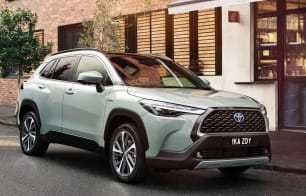Thinking about it, the Ignis is uniquely suited to city life.
Forget its diminutive proportions for a moment, and consider instead that it has extraordinarily high seating positions and a tall turret. Perfect for stepping inside the car with some degree of dignity.
Once sat on the big, comfy and lofty front seats, you’re immediately struck by how confidence-building the commanding driving position, assisted by the excellent all-round vision afforded by the deep glass area and upright pillars and a pleasant leather-like steering wheel cover.
The front buckets themselves are comfy and enveloping, even though there is no lumbar adjustment support fitted; there is a height lever on the driver’s side, ample rearward travel for taller folk and side bolstering to help hug you through corners, while the soft cloth material feels good to the touch.
Suzuki’s thought about storage, as demonstrated by the big glovebox, bottle-holding door pockets up front, deep lower-console shelf and trio of cupholders, though there is no central armrest or bin, even in this up-spec grade.
Suzuki’s gone for a somewhat old-school off-roader theme inside, evidenced by the chunky heater/air-con controls, toggle switchgear and 4x4-look pared-back dash, while there’s plenty of hardy, hollow-sounding plastics to remind you that this is built down to a price. One lovely retro detail is the ‘60s pull-out bonnet release.
Operating the GLX’s climate control is child’s play, and the same applies to the ageing but still effective multimedia system, with its colourful display, easy connectivity and handy sat-nav. Note that the virtual volume slider on the screen is slow, fiddly and ultimately needlessly distracting. Give us a proper knob any day of the week. And what about a digital radio receiver, please, Suzuki?
We’re also less fond of the tilt-only non-telescopic steering column, as some drivers found it difficult to find the perfect position as a result, while the lack of digital speedo when there is room for it in the instrumentation’s LCD window smacks of penny pinching. Otherwise, the Ignis’ layout and design generally really hit the mark.
The rear doors open at nearly 90 degrees, aiding entry to and egress from the back seat. Although the front passenger seat lacks a height adjuster, it is still set up high, so big feet can tuck in underneath for taller occupants behind.
Being a GLX, the bench is split 50/50, is designed to only carry two people (so there’s no centre belt but ample width as a consequence) and the backrest reclines in 10 (narrow) positions for added comfort. Both also slide forward by a significant amount, boosting cargo space. Parents and guardians of smaller children might find this helpful as they can be positioned closer to the front seats for access that’s within arm’s reach.
The backrests themselves are… OK and clearly intended for smaller folk. Your 178cm tester found a distinct lack of under-thigh support due to the short squab and the backrest doesn’t reline far enough back for true comfort. And except for the aforementioned third cupholder nestled right at the rear of the front-seat lower-console area, door-pull recess that might hold an upright smartphone as well as a small bottle receptacle built into the door card, storage is non-existent back there. Yes, there is one map pocket, but that’s your lot. You’ll also search in vain for overhead grab handles (only the front passenger gets one), reading lights and rear-seat centre armrest – a wasted opportunity given this car’s four-seater status.
On the other hand, there’s space galore in every direction due to that very status, excellent vision and windows that wind (electrically of course) all the way down for a light and airy feel. Fido will be pleased. Just remember to bring your ear plugs if constant road noise bothers you.
Further back, you’ll marvel at the versatility of the cargo area, thanks to the sliding split bench that increases cargo capacity from 264 litres in normal four-seat mode to 515L with the backrests folded and 1104L in “maximum volume” mode. Note the five-seater GL’s ranges from 271L to 505L to 1101L respectively.
It’s properly long and deep in this setting. There’s a deep floor (with a space-saver spare underneath) and a light, but not much else. The fit and finish is fine but the floor seems flimsy and the parcel shelf lightweight. At least it isn’t mesh as per the Honda HR-V’s.

